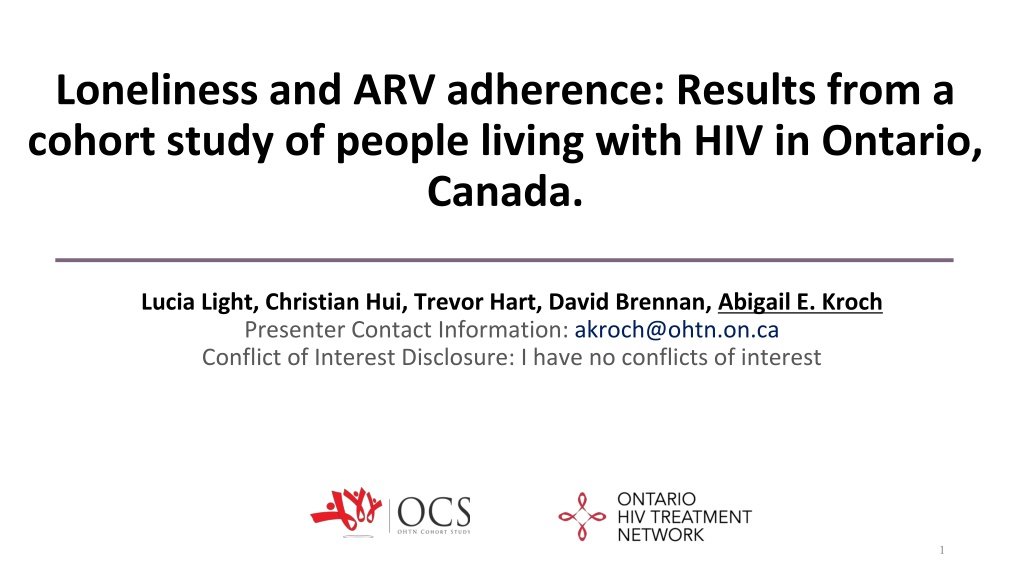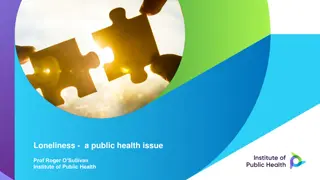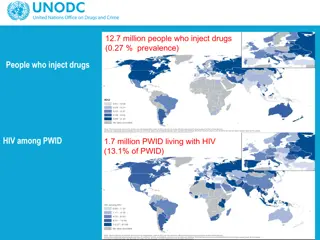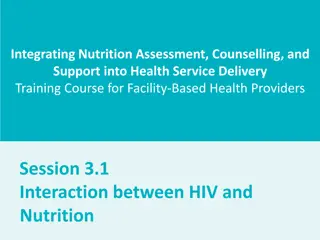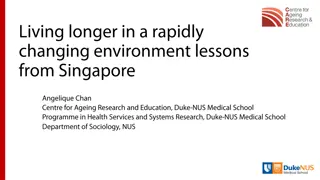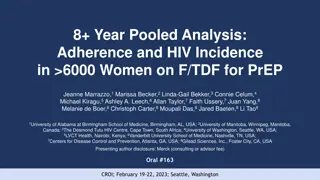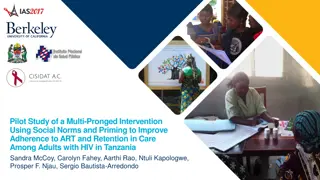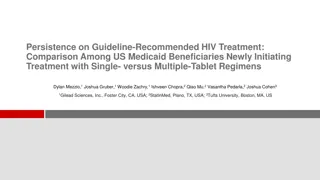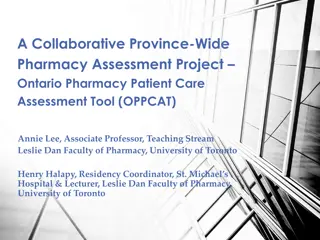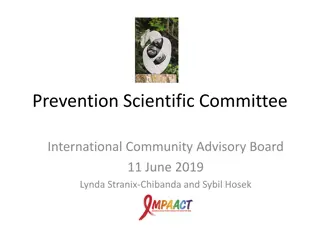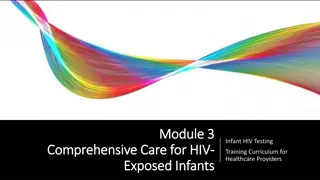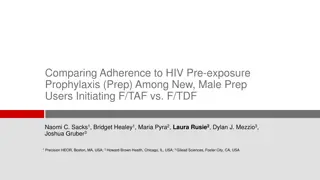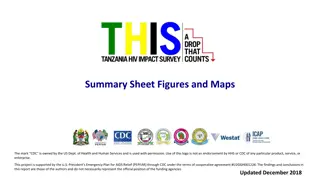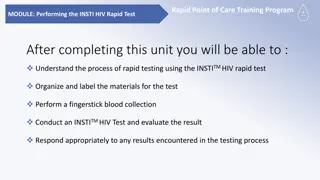Loneliness and ARV Adherence among People Living with HIV in Ontario, Canada
This study investigates the impact of loneliness on antiretroviral medication adherence among individuals living with HIV in Ontario. Utilizing the Ontario HIV Cohort Study, researchers assessed loneliness levels and adherence through questionnaires, finding associations between loneliness severity and medication adherence. Statistical analyses included chi-square tests and logistic regression modeling. Results suggest a potential link between loneliness and ARV adherence, highlighting the importance of addressing social well-being in HIV care.
Download Presentation

Please find below an Image/Link to download the presentation.
The content on the website is provided AS IS for your information and personal use only. It may not be sold, licensed, or shared on other websites without obtaining consent from the author. Download presentation by click this link. If you encounter any issues during the download, it is possible that the publisher has removed the file from their server.
E N D
Presentation Transcript
Loneliness and ARV adherence: Results from a cohort study of people living with HIV in Ontario, Canada. Lucia Light, Christian Hui, Trevor Hart, David Brennan, Abigail E. Kroch Presenter Contact Information: akroch@ohtn.on.ca Conflict of Interest Disclosure: I have no conflicts of interest 1
Project Rationale Loneliness is often defined as a subjective experience that causes distress over the absence of social contact, belonging or a sense of being alienated. Loneliness is independently associated with a diverse range of mental health concerns or issues, including depression, anxiety, self-harm, suicidality and service use. Our goal was to investigate the degree of loneliness experienced by people living with HIV (PLWH) and its impact on adherence to ARV medications using Ontario HIV Cohort Study (OCS). 2
What is the OHTN Cohort Study (OCS)? A community governed, longitudinal cohort study of people living with HIV >8000 participants since 1995 15 clinics across Ontario Collects clinical data and annual interviewer-administered questionnaires ~2000 questionnaires collected in 2020 Check out the OCS at: www.ohtncohortstudy.ca 3
Methods: UCLA 3-item loneliness scale In 2020, a 3-item short UCLA Loneliness Scale was added to the annual questionnaire: 1.How often do you feel that you lack companionship? 2. How often do you feel left out? 3. How often do you feel isolated from others? Response options:Hardly ever, Some of the time, Often. Combined loneliness score: Range: 3-9 categorized into 3 categories: Low: 3-4, Medium: 5-6, High: 7-9 4
Methods: Adherence to Antiretroviral (ARV) medications Are you currently taking antiretroviral medications? When was the last time you missed taking any of your medications? Response options: Never skipped medications, Within the past week, 1-2 weeks ago, 1-3 months ago, More than 3 months ago. Among those who are currently on ARV we dichotomized answers: Never skipped or skipped more than 3 months ago, Skipped recently less than 3 months ago 5
Statistical methods Descriptive statistics, chi-square test Logistic regression Proportional odds model (POM) o is a class of generalized linear models used for modelling the dependence of an ordinal response on discrete or continuous covariates. o The key assumption in proportional odds model is that the effects of any explanatory variables are consistent or proportional across the different levels of the outcome. o In POM odds ratios can be interpreted as constant across the entire range of the outcome. o We used SAS proc logistic to fit POM to 3 ordered levels of the combined Loneliness score: Low, Medium, High. 6
Results: Participant Demographics 1,870 participants had completed Loneliness scale questions as of 10-JUNE-2021 Mean age (STD): 52.2 (12.1) From May June 2021, participants identified as: 60.0% Gender Identity Female Male Non-Binary 21.7% (n=403) 71.3% (n=1324) 7.0% (n=129) Sexual Orientation 21.7% 15.8% Heterosexual LGBQ 35.4% (n=658) 64.6% (n=1198) 2.5% 36.6% had less than $20,000 of Personal gross income/year 61.0% are single or widowed or divorced 37.4% were born outside Canada 11.8% use non-medicinal drugs 9.4% - harmful alcohol use (AUDIT scale) 75.4% lived with HIV more than 10 years Black (N=397) White (N=1099) Indigenous (N=46) Other (N=289) 7
Results: Loneliness questions and combined Loneliness score How often do you feel that you lack companionship? Combined 3-item Loneliness scale score 49.6% 30.8% Almost half of the participants experience medium or high loneliness levels 19.6% 52.2% 13% to 20% of participants experience at least one of the three aspects of loneliness Hardly ever Some of the time Often How often do you feel left out? 60.7% 27.1% 20.7% 26.1% 13.2% Hardly ever Some of the time Often How often do you feel isolated from others? Low (3-4) Medium (5-6) High (7-9) 53.0% Combined loneliness score Median = 3, IQR = 4-6. 29.0% 17.9% 8 Hardly ever Some of the time Often
Results: Loneliness differs across demographics Sex at birth (p1=0.01) Age (p1<.0001) 80% 71.3% 70% 54.2% 54.0% 60% 45.9% 45.4% 50% 42.9% 33.6% 40% 32.2% 30.5% 26.0% 24.7% 23.6% 23.6% 30% 22.4% 21.3% 19.8% 17.9% 20% 10.8% 10% 0% Female Male less than 34 35-49 50-64 65 or more Low (3-4) Medium (5-6) High (7-9) Low (3-4) Medium (5-6) High (7-9) Marital status (p1<.0001) Gross Personal yearly income (p1<.0001) 80% 71.9% 70% 57.9% 60% 50% 41.6% 39.6% 40% 30.6% 31.2% 29.2% 27.8% 25.4% 30% 20.8% 16.7% 20% 7.2% 10% 0% less than $20,000 $20,000 or more Married/with Partner Single/Widowed/Divorced Low (3-4) Medium (5-6) High (7-9) Low (3-4) Medium (5-6) High (7-9) 9 1 Chi-square test p-value
Independent Predictors of Loneliness: Proportional Odds Model results1 Unadjusted OR(95%CI) 2.18 (1.89, 4.21) 3.07 (2.24, 4.21) 2.18 (1.62, 2.93) 1 1.93 (1.60, 2.31) Adjusted OR(95%CI)2 Independent predictors Predictor Categories <35 35-49 50-64 65+ < $20,000 $20,000+ Yes No Single/Widowed/Divorced Married/Living with partner Yes No Female Male Black Indigenous Other White 2.84 (1.80, 4.48) 3.18 (2.22, 4,56) 2.18 (1.57, 3.03) 1 1.51 (1.23, 1.85) Age Gross personal yearly income 1 1 1.67 (1.25, 2.23) 1 4.12 (3.39, 5.03) 1.49 (1.08, 2.07) 1 4.04 (3.26, 5.00) Harmful Alcohol use Marital status 1 1 2.09 (1.60, 2.73) 1 1.34 (1.09, 1.65) 1 0.99 (0.80, 1.25) 1.88 (1.07, 3.29) 0.93 (0.73, 1.20) 1 1.52 (1.13, 2.06) 1 1.38 (1.06, 1.79) 1 0.67 (0.5, 0.89) 1.06 (0.56, 2.00) 0.78 (0.59, 1.03) 1 Non-medicinal drug use Sex at birth Race 1 Probabilities are modeled over lower ordered values of combined loneliness scores 2 Final model was chosen to satisfy the test for proportional odds assumption. 10
Adherence to Antiretroviral (ARV) medications When was the last time you missed taking any of your medications? Non-adherence to ARV1 and Loneliness (p2<.0001) 57.2% We found strong association between ARV non-adherence and higher loneliness scores 44.1% 30.5% 25.4% 25.3% 17.5% Low (3-4) Medium (5-6) High (7-9) Never skipped or skipped > 3 months ago Skipped recently (< 3 months ago) 1 - Among participants who are on antiretroviral medications 2 - Chi-square test p-value 11
Loneliness as predictor1 for ARV non-adherence Independent predictors of adherence to ARV medications1 Predictor Categories Unadjusted OR(95%CI) Adjusted OR(95%CI) 1 1 Low (3-4) Medium (5-6) High (7-9) <35 35-49 50-64 65+ Female Male Black Indigenous Other White Yes No Loneliness scale 1.53 (1.23, 1.90) 1.80 (1.41, 2.29) 4.00 (2.61, 6.13) 2.07 (1.51, 2.83) 1.80 (1.34, 2.41) 1 0.74 (0.59, 0.93) 1 0.59 (0.47, 0.75) 0.74 (0.39, 1.48) 0.97 (0.74, 1.26) 1 2.67 (1.91, 3.74) 1 3.75 (2.69, 5.22) 1 1.45 (1.14, 1.84) 1.41 (1.08, 1.85) 3.59 (2.24, 5.74) 1.85 (1.30, 2.63) 1.55 (1.13, 2.12) 1 0.88 (0.67, 1.16) 1 0.62 (0.47, 0.84) 0.74 (0.39, 1.48) 0.92 (0.69, 1.48) 1 2.00 (1.38, 2.91) 1 2.55 (1.79, 3.64) 1 Age Sex at birth Race Harmful Alcohol use Non-medicinal drug useYes No 1 in Logistic regression model, adjusted for age, sex, race alcohol and non-medicinal drug use. 12
Conclusions PLWH with higher loneliness scores are more likely to skip or misstheir ARV medications. About 13% to 20% of OCS participants experienced at least one of the three aspects of loneliness, almost half have high scores on the combined loneliness scale. Younger age is associated with both - higher loneliness scores and non-adherence to ARV medications. More research is needed to identify relationship between loneliness and co-morbid conditions, such as substance use. Intervention strategies are need in communities of PLWH to combat loneliness, especially during current COVID-19 pandemic. 13
Acknowledgements People living with HIV who organized to create the OCS, contribute to the data in the OCS, support the governance of data, and guide the research process. OCS Participants, interviewers, data collectors, research associates and coordinators, nurses and physicians who provide support for data collection, OCS staff for data management, IT support, and study coordination. We also acknowledge the Public Health Ontario, for supporting linkage with the HIV viral load database. The OHTN Cohort Study is supported by the Ontario Ministry of Health. The OHTN Cohort Study Team consists of Dr. Abigail Kroch (PI), Dr. Ann Burchell (Co-I), Anita Beniot (Co-I), Lawrence Mbuagbaw (Co-I), Sergio Rueda (Chair SSC), Dr. Corinna Quan, Dr. Curtis Cooper, Dr. Gordon Arbess, Elizabeth Lavoie, Dr. Mona Loutfy, Dr. David Knox, Dr. Nisha Andany, Dr. Sharon Walmsley, Dr. Michael Silverman, Tammy Borque, Dr. Phillipe El-Helou, Holly Gauvin, Wangari Tharao, Dr. Alan Li, Dr. Jeffrey Craig and Dr. Jorge Martinez-Cajas. OCS Governance Committee: Jasmine Cotnam, Tony Di Pede, Barry Adam, Viviana Santiba ez, Rodney Rousseau, Mary Ndung u, YiYi Chen, Ruth Cameron, Jason Brophy, Aaron Bowerman, Dane Record, Elisio Muchano and Cornel Grey OCS Indigenous Data Governance Circle: Jasmine Cotnam, Randy Jackson, Meghan Young, and Trevor Stratton OCS Scientific Steering Committee: Sergio Rueda, Ann Burchell, Barry Adam, David Brennan, Curtis Cooper, Trevor Hart, Mona Loutfy, Kelly O Brien, Lawrence Mbuagbaw, Pierre Giguere, Anita Benoit, Lance McCready, and Sean Hillier. OCS staff: Agatha Nyambi, Lucia Light, Nahid Qureshi, Tsegaye Bekele, Maya Kesler, Sean Colyer, Kristen O Brien, Adanna Obioha, Namita Prabhu, and Maxwell Groves. We also acknowledge the Public Health Laboratories, Public Health Ontario, for supporting record linkage with the HIV viral load database. The opinions, results and conclusions are those of the authors and no endorsement by the Ontario HIV Treatment Network or Public Health Ontario is intended or should be inferred. 14
Questions? Thank you for your time! Please feel free to contact us at: llight@ohtn.on.ca akroch@ohtn.on.ca 15
